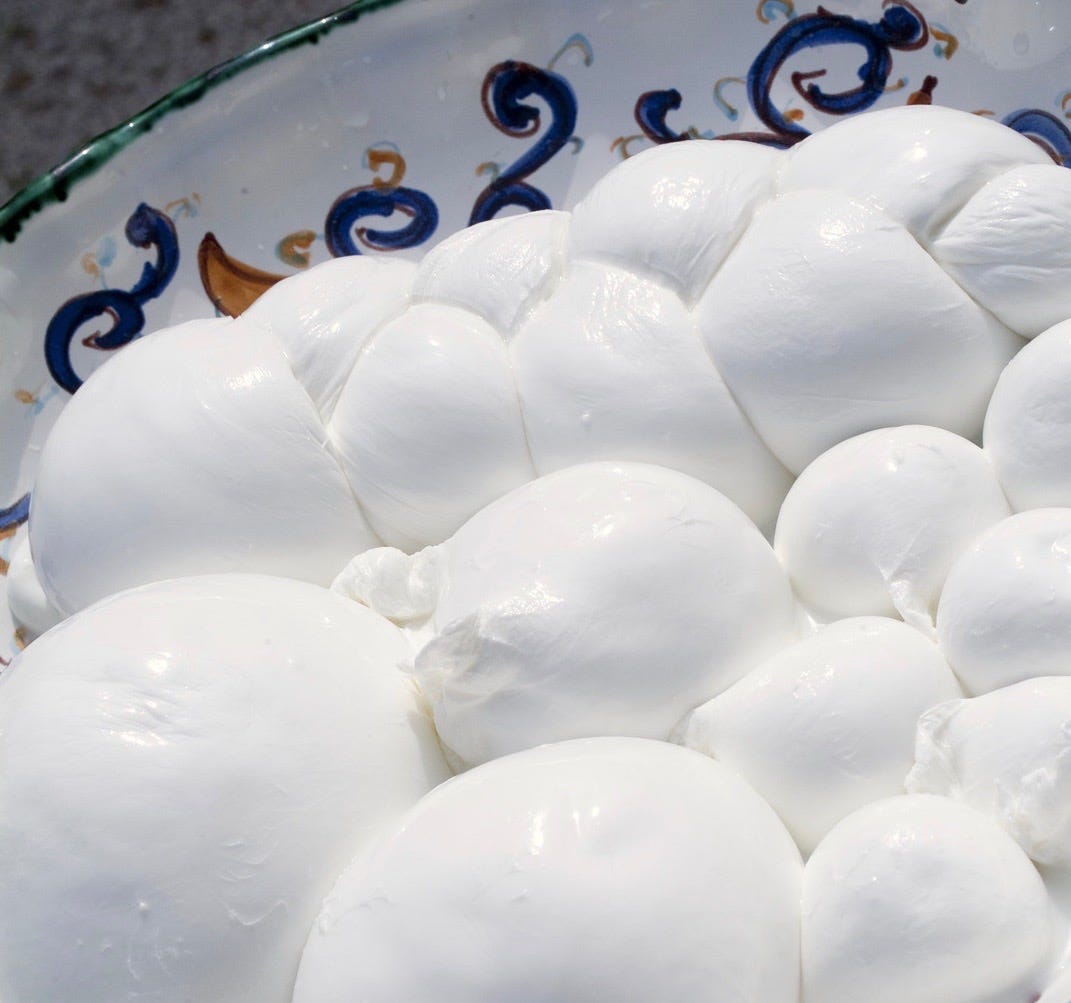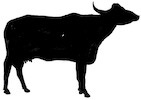Cheese Anthology Index
appellation: Denominazione di Origine Protetta (DOP).
place: most of the region of Campania as well as (incongruously) parts of Lazio and Puglia (plus one commune in Molise), Italy.
milk: water buffalo (Italian Mediterranean breed), raw, heat-treated, or pasteurized.
type: pasta filata, utterly fresh.
size: highly varied, typically irregular balls, often weighing 25 to 50 gr (bocconcini) or 250 to 400 gr (a sort of basic size), but anywhere from 10 gr to a maximum of 800 gr, except up to 3 kilos for braids.
production: just over 100 dairy plants, including some on farms; a total, consistently climbing, now more than 47,000 metric tonnes each year.
related cheeses: cow’s-milk mozzarella, also called fior di latte in Italy, when made with care using the same techniques, and Burrata di Andria.
look for: freshness, ideally a cheese made on the day you buy it; if possible, a raw-milk cheese; always a porcelain white color; and, when the cheese is sliced, some “milk” flowing from the inner layers.
taste: In contrast to the cow’s-milk version, Mozzarella di Bufala has much more character; fresh lactic aromas combine tartness, creaminess, and buffalo flavor. Mozzarella di Bufala is also, from producer to producer, one of the least consistent cheeses, including in salt.
drinks: With fresh mozzarella, no particular drink is needed.
MOZZARELLA DI BUFALA — the original mozzarella — is texturally much more interesting than cow’s-milk mozzarella; it's much richer and much more flavorful, due to the buffalo milk, which contains more protein than cow’s milk and more than twice as much fat, an average of 8.5 percent. Buffalo mozzarella, covered by a very thin skin, is white throughout, with no hint of the carotene yellow of cow’s milk. The lactic aroma brings to mind freshly cut grass. The taste is an interplay among acidity, creaminess, and buffalo flavor. The acidity recalls that of real yogurt, and the buffalo component is distinctly animal — in that way more like sheep than cow. The common Italian description of buffalo flavor is muschiato, “musky.” It can be especially apparent, usually in a positive way, in the old combination of bocconcini (“mouthfuls”) in buffalo cream. Often the elements come wonderfully together, but from producer to producer the balance and flavors vary enormously. Some cheeses have very little salt, an off-putting sourness, or too much animal. When you bite into the new-made cheese, an important part of the pleasure comes from the tender, springy resistance and from the moisture between the layers, which are more pronounced than in even the best cow’s-milk versions. Mozzarella di Bufala retains its special texture for only eight to ten hours, before the layers gradually meld and firm. The territory of Mozzarella di Bufala Campana, the official controlled-place name cheese, mainly comprises the original area around Naples in the south of Italy. No buffalo mozzarella made outside Italy — none I’ve tasted — comes anywhere close to the original. Mozzarella di Bufala is the single fresh cheese that can be called great.
It was only in the 1980s that the buffalo-mozzarella producers lost control over the name “mozzarella” in a legal battle, so that even in Italy the cow’s-milk version may be sold as “mozzarella,” though it’s often still distinguished as fior di latte. The mozzarella used on nearly all pizza, in Italy as everywhere, is an especially firm, dry, cow’s-milk kind that hardly seems related to the buffalo one. There’s much better cow’s-milk mozzarella than that, but even the best and freshest offers only a butterlike aroma. Press on it, and it hardly yields at all. Cut it, and it releases little or no liquid. As time passes, it hardens more quickly. It’s not necessarily a bad cheese — it can be very fresh and good — but its advantage is its low price.
Despite Mozzarella di Bufala’s higher cost and the need for freshness, it’s enormously popular. From the 12,000 water buffalo that existed in all of Italy shortly after the Second World War, the figure has risen to an extraordinary 400,000, which reflects the huge contemporary demand for real buffalo mozzarella. Annual production of Mozzarella di Bufala Campana is the fourth largest of any Italian DOP cheese, after Grana Padano, Parmigiano Reggiano, and Gorgonzola. Despite the adjective campana in the DOP name, the animals are found and the cheese is made in an area that runs from Campania, the region that produces most Mozzarella di Bufala, into neighboring Lazio, and the rules allow the DOP cheese to be made in a few other places as well. Of the cheese made in Campania, nearly 60 percent comes from the province of Caserta, just north of Naples, and about a third from the province of Salerno, south of the city. About a quarter of the production is exported.
The work is still done largely by hand, though more so at some producers than others. The milk is acidified by adding whey full of bacteria from previous mozzarella-making; then enough rennet goes in to form a curd in about 20 minutes. The curd is broken, but what follows isn’t standardized. The key is maturing the curd: it rests in its whey for roughly five hours, while the rising acidity gives an impressive elasticity. As a test, a small piece of curd is put into hot water and stretched; if its threads extend more than a meter, it's ready.
After the curd is taken from the whey, it's reduced to thin slices, which are piled up and left for a short time to drain further. To complete the transformation to pasta filata, which literally means “spun paste” and is usually translated into English as “string cheese,” the curd is put into a tub along with water at just under boiling temperature. The curd is stirred and worked, traditionally using a bowl and a wooden stick, stretching out the fibers as the pieces come together in a smooth, shiny mass.
Finally, the soft cheese is mozzata — “cut off,” the verb that gives the cheese its name — into pieces of the desired size, typically balls, though sometimes it is given more special shapes. Certain producers still separate the pieces by hand, one worker holding the mass of mozzarella, while a second squeezes and pulls them away. The pieces go into a brine, remaining for a shorter or longer time according to their size. When they’re considered salty enough, they’re transferred to another liquid, commonly a very mild and acidic brine, to wait for customers. Often they’re packaged with that brine in small plastic bags or other containers. Sometimes mozzarella is smoked.
Differences in the taste from producer to producer result from the use of raw or pasteurized milk, from the particular, presumably indigenous cultures in the whey, and from the details of method and timing. A group of Italian tasters in 2014 found that mozzarella tended to be superior when it came from cheese plants working with milk from their own farms. The reason might be greater care on a smaller scale or it might be that the milk tends to be fresher and cleaner, less exposed to air, and undamaged by transport or pumping.
The best place to get to know the cheese is the traditional area in Campania, where a restaurant might offer you, to eat all by yourself, a rather large whole ball, either with nothing on it or with only olive oil and black pepper. With raw-milk Mozzarella di Bufala, some people wait a day or two for the texture to relax and become more tender and even for the flavor itself to improve. Admirers in the region don’t refrigerate the cheese — it has better texture and more flavor at 10 to 21 degrees C (50 to 70 degrees F). DOP rules allow Mozzarella di Bufala Campana to be sold for up to ten days, but when I first visited a producer back in the 1990s, he told me that in the region the cheese was always eaten within 24 hours. Even now, those who care about the cheese consider it fresh for two to three days at most.
Mozzarella is firmly tied to the vibrant city of Naples, although Neapolitan recipes today often call for cow’s-milk mozzarella, because of the lower cost and because the superiority of buffalo-milk mozzarella is less obvious when the cheese is cooked. Either kind goes into the filling for calzone, into lasagna, and into eggplant parmigiana, which despite its name has nothing to do with the northern city of Parma. (It’s found in Naples and a Sicily — its origins are contentious.) Mozzarella is sometimes breaded and fried. It goes into the savory filling for the baked rice dish sartù. And for both flavor and texture, real Mozzarella di Bufala is the only cheese that makes sense in insalata caprese, with its alternating slices of ripe tomato and mozzarella, dressed simply with olive oil, salt, and fresh basil. When all those are very good, they form a superb combination. Even in Naples, the home of pizza, Mozzarella di Bufala is seldom put on pizza today, because of the cost and because in the oven’s intense heat the rich, moist buffalo cheese exudes liquid and almost disappears from sight. But at a good pizzeria, Mozzarella di Bufala is usually an option — it's the most delicious choice. ●






